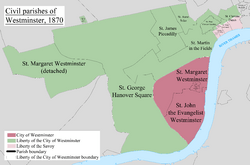St Paul Covent Garden facts for kids
| St Paul Covent Garden | |
 |
|
| Geography | |
| Status | Civil parish |
| 1881-1921 area | 26 acres (0.11 km2) |
| History | |
| Created | 1645 |
| Abolished | 1922 |
| Succeeded by | City of Westminster (parish) |
Quick facts for kids Demography |
|
|---|---|
| 1881 population | 2,919 |
| 1921 population | 1,063 |
| Politics | |
| Governance | St Paul Vestry (1645–1855) Strand District Board of Works (1855–1900) |
St Paul Covent Garden was a special local area in London, England. It was like a small town within the bigger city. This area is now part of the famous Covent Garden market and the streets around it in the City of Westminster.
Contents
What Was St Paul Covent Garden?
St Paul Covent Garden was known as a civil parish. Think of a civil parish as a local district with its own rules and ways of managing things. It was a way to organize local government and services for people living there.
A Look Back: History of St Paul Covent Garden
How the Parish Began
St Paul Covent Garden was created in 1645. It was formed from a part of an older, larger area called St Martin in the Fields. This new parish was located within the Liberty of Westminster, which was a special area with its own local laws.
Location and Neighbors
The parish of St Paul Covent Garden was quite unique because it was completely surrounded by the parish of St Martin in the Fields. Imagine a small island in the middle of a larger landmass!
Joining the Strand District
In 1855, St Paul Covent Garden became part of the Strand District. This meant it was now under the care of the Metropolitan Board of Works. This board helped manage public services for many areas in London.
Becoming Part of London
Later, in 1889, the parish became part of the new County of London. This was a big step in how London was governed. Then, in 1900, it joined the Metropolitan Borough of Westminster.
When the Parish Ended
St Paul Covent Garden stopped being a civil parish in 1922. Its responsibilities were then taken over by other local government bodies.
Helping Those in Need: Poor Law
The parish also played a role in helping people who were struggling. It had a workhouse in Cleveland Street, Marylebone. From 1836, this workhouse became part of the Strand Poor Law Union. This union was a group of parishes that worked together to provide help and support for poor people in their area.

